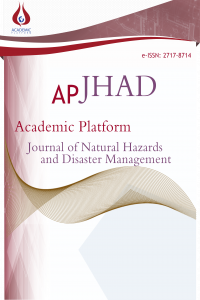Fiber Based Modeling Strategies of RC Columns
Fiber Based Modeling Strategies of RC Columns
Fiber Elements, Reinforced Concrete, Calibration Finite Elements, OpenSees,
___
- Referans1 T. B. Panagiotakos and M. N. Fardis, “Deformations of reinforced concrete members at yielding and ultimate,” ACI Structural Journal, vol. 98, no. 2, pp. 135–148, 2001.
- Referans2 Baker and A. L. L., “The ultimate load theory applied to the design of reinforced & prestressed concrete frames,” Concrete Publications Ltd. London., 1956.
- Referans3 Sawyer and H. A., “Design of concrete frames for two failure stages,” ACI Structural Journal, pp. 405–437, 1964.
- Referans4 Corley and W. G., “Rotational capacity of reinforced concrete beams,” Journal of the Structural Division, vol. 92, no. 5, pp. 121–146.
- Referans5 A. H. Mattock, “Discussion of Rotation Capacity of Reinforced Concrete Beams.,” Journal of the Structural Division, vol. 93, no. 2, pp. 519–522, 1967.
- Referans6 T. Paulay and M. J. N. Priestley, Seismic Design of Reinforced Concrete and Masonry Buildings. Wiley, 1992.
- Referans7 A. E. Naaman et al., “Reinforced and Prestressed Concrete Using HPFRCC Matrices,” High Performance Fiber Reinforced Cement 825 Composites 2, pp. 291–347, 1996.
- Referans8 M. P. Berry and M. O. Eberhard, “Performance Modeling Strategies for Modern Reinforced Concrete Bridge Columns,” Seattle, 2007.
- Referans9 H. Tariq, E. A. Jampole, and M. J. Bandelt, “Fiber-hinge modeling of engineered cementitious composite flexural members under large deformations,” Engineering Structures, vol. 182, pp. 62–78, 2019.
- Referans10 A. M. R. R. W. Gregory G. Deierlein, «Nonlinear Structural Analysis For Seismic Design,» 2010.
- Referans11 «PEER Structural Performance Database,» 2003. [Çevrimiçi]. Available: https://nisee.berkeley.edu/spd/index.html.
- Referans12 O. B. a. S. A. Sheikh, «Confinement Steel Requirements For High Strength Concrete Columns,» Elsevier Science, 1996.
- Referans13 A. B. Matamoros, Study of Drift Limits For High-Strength Concrete Columns, 1994.
- Referans14 T. O. a. T. Nishioka, «An Experimental Study on Energy Absorption Capacity of Columns in Reinforced Concrete Structures,» Structural Engineering, October 1984.
- Referans15 M. S. a. M. Grira, «Confinement of Reinforced Concrete Columns With Welded Reinforcement Grids,» ACI Structural Journal, February 1999.
- Referans16 M. S. a. G. Ozcebe, «Response of Reinforced Concrete Columns to Simulated Seismic Loading,» ACI Structural Journal, February 1989.
- Referans17 J. Tanaka, Effect of Lateral Confining Reinforcement on the Ductile Behavior of Reinforcement Concrete Columns, 1990.
- Referans18 J. P. A. R. P. Armando Calabrese, «Numerical Issues in Distributed Inelasticity Modeling of RC Frame Elements for Seismic Analysis,» Journal of Earthquake Engineering , 24 Mar 2010.
- Referans19 «The Open System for Earthquake Engineering Simulation,» 2006. [Çevrimiçi]. Available: https://opensees.berkeley.edu/.
- Yayın Aralığı: Yılda 2 Sayı
- Başlangıç: 2020
- Yayıncı: Akademik Perspektif Derneği
Bülent BÜYÜKKIDAN, Hüseyin GÜMÜŞ, Ömer Ahmet USLU
Sushil KHANDURİ, Piyoosh RAUTELA
Fiber Based Modeling Strategies of RC Columns
Fazıl Abdulkadir ÇAĞLAR, Tuba TATAR
Seismicity of Turkey and Real-Time Seismology Applications in Determining Earthquake Hazard
